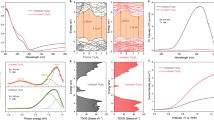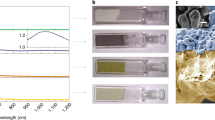Abstract
Ta3N5 is a promising photoanode material with a theoretical maximum solar conversion efficiency of 15.9% for photoelectrochemical water splitting. However, the highest applied bias photon-to-current efficiency achieved so far is only 2.72%. To bridge the efficiency gap, effective carrier management strategies for Ta3N5 photoanodes should be developed. Here, we propose to use gradient Mg doping for band structure engineering and defect control of Ta3N5. The gradient Mg doping profile in Ta3N5 induces a gradient of the band edge energetics, which greatly enhances the charge separation efficiency. Furthermore, defect-related recombination is significantly suppressed due to the passivation effect of Mg dopants on deep-level defects and, more importantly, the matching of the gradient Mg doping profile with the distribution of defects within Ta3N5. As a result, a photoanode based on the gradient Mg-doped Ta3N5 delivers a low onset potential of 0.4 V versus that of a reversible hydrogen electrode and a high applied bias photon-to-current efficiency of 3.25 ± 0.05%.

This is a preview of subscription content, access via your institution
Access options
Access Nature and 54 other Nature Portfolio journals
Get Nature+, our best-value online-access subscription
$29.99 / 30 days
cancel any time
Subscribe to this journal
Receive 12 digital issues and online access to articles
$119.00 per year
only $9.92 per issue
Buy this article
- Purchase on Springer Link
- Instant access to full article PDF
Prices may be subject to local taxes which are calculated during checkout






Similar content being viewed by others
Data availability
The data that support the findings of this study are available from the corresponding author on request. Source data are provided with this paper.
References
Lewis, N. S. Toward cost-effective solar energy use. Science 315, 798–801 (2007).
Listorti, A., Durrant, J. & Barber, J. Artificial photosynthesis: solar to fuel. Nat. Mater. 8, 929–930 (2009).
Hammarstrom, L. & Hammes-Schiffer, S. Artificial photosynthesis and solar fuels. Acc. Chem. Res. 42, 1859–1860 (2009).
Bard, A. J. & Fox, M. A. Artificial photosynthesis: solar splitting of water to hydrogen and oxygen. Acc. Chem. Res. 28, 141–145 (1995).
Tachibana, Y., Vayssieres, L. & Durrant, J. Artificial photosynthesis for solar water-splitting. Nat. Photon. 6, 511–518 (2012).
House, R. L. et al. Artificial photosynthesis: where are we now? Where can we go? J. Photochem. Photobiol. C 25, 32–45 (2015).
Hisatomi, T., Kubota, J. & Domen, K. Recent advances in semiconductors for photocatalytic and photoelectrochemical water splitting. Chem. Soc. Rev. 43, 7520–7535 (2014).
Ran, J. et al. Earth-abundant cocatalysts for semiconductor-based photocatalytic water splitting. Chem. Soc. Rev. 43, 7787–7812 (2014).
Hu, S. et al. An analysis of the optimal band gaps of light absorbers in integrated tandem photoelectrochemical water-splitting systems. Energy Environ. Sci. 6, 2984–2993 (2013).
Döscher, H., Geisz, J. F., Deutsch, T. G. & Turner, J. A. Sunlight absorption in water-efficiency and design implications for photoelectrochemical devices. Energy Environ. Sci. 7, 2951–2956 (2014).
Li, Y. et al. Vertically aligned Ta3N5 nanorod arrays for solar‐driven photoelectrochemical water splitting. Adv. Mater. 25, 125–131 (2013).
Li, Y. et al. Cobalt phosphate-modified barium-doped tantalum nitride nanorod photoanode with 1.5% solar energy conversion efficiency. Nat. Commun. 4, 2566 (2013).
Liu, G. et al. Enabling an integrated tantalum nitride photoanode to approach the theoretical photocurrent limit for solar water splitting. Energy Environ. Sci. 9, 1327–1334 (2016).
Pihosh, Y. et al. Ta3N5-nanorods enabling highly efficient water oxidation via advantageous light harvesting and charge collection. Energy Environ. Sci. 13, 1519–1530 (2020).
Hitoki, G. et al. Ta3N5 as a novel visible light-driven photocatalyst (λ<600 nm). Chem. Lett. 31, 736–737 (2002).
Chun, W.-J. et al. Conduction and valence band positions of Ta2O5, TaON, and Ta3N5 by UPS and electrochemical methods. J. Phys. Chem. B 107, 1798–1803 (2003).
Ding, C., Shi, J., Wang, Z. & Li, C. Photoelectrocatalytic water splitting: significance of cocatalysts, electrolyte, and interfaces. ACS Catal. 7, 675–688 (2016).
He, Y. et al. What limits the performance of Ta3N5 for solar water splitting? Chem 1, 640–655 (2016).
Wang, Z. et al. Overall water splitting by Ta3N5 nanorod single crystals grown on the edges of KTaO3 particles. Nat. Catal. 1, 756–763 (2018).
Seo, J., Nishiyama, H., Yamada, T. & Domen, K. Visible‐light‐responsive photoanodes for highly active, stable water oxidation. Angew. Chem. Int. Ed. 57, 8396–8415 (2018).
Seo, J. et al. Mg-Zr cosubstituted Ta3N5 photoanode for lower-onset-potential solar-driven photoelectrochemical water splitting. J. Am. Chem. Soc. 137, 12780–12783 (2015).
Pei, L. et al. Oriented growth of Sc-doped Ta3N5 nanorod photoanode achieving low-onset-potential for photoelectrochemical water oxidation. ACS Appl. Energy Mater. 1, 4150–4157 (2018).
Boettcher, S. W. et al. Photoelectrochemical hydrogen evolution using Si microwire arrays. J. Am. Chem. Soc. 133, 1216–1219 (2011).
Lin, Y. et al. Growth of p-type hematite by atomic layer deposition and its utilization for improved solar water splitting. J. Am. Chem. Soc. 134, 5508–5511 (2012).
Abdi, F. F. et al. Efficient solar water splitting by enhanced charge separation in a bismuth vanadate-silicon tandem photoelectrode. Nat. Commun. 4, 2195 (2013).
Xie, Y., Wang, Y., Chen, Z. & Xu, X. Role of oxygen defects on the photocatalytic properties of Mg‐doped mesoporous Ta3N5. ChemSusChem 9, 1403–1412 (2016).
Fukasawa, Y. et al. Synthesis of ordered porous graphitic‐C3N4 and regularly arranged Ta3N5 nanoparticles by using self‐assembled silica nanospheres as a primary template. Chem. Asian J. 6, 103–109 (2011).
Li, W.-K., Zhou, G.-D., Mak, T. C. W. & Mak, T. Advanced Structural Inorganic Chemistry (Oxford Univ. Press, 2008).
Fu, G., Yan, S., Yu, T. & Zou, Z. Oxygen related recombination defects in Ta3N5 water splitting photoanode. Appl. Phys. Lett. 107, 171902 (2015).
Cui, L., Wang, M. & Wang, Y. X. Nitrogen vacancies and oxygen substitution of Ta3N5: first-principles investigation. J. Phys. Soc. Jpn 83, 114707 (2014).
Jing, T., Dai, Y., Ma, X., Wei, W. & Huang, B. Effects of intrinsic defects and extrinsic doping on the electronic and photocatalytic properties of Ta3N5. RSC Adv. 5, 59390–59397 (2015).
Harb, M. et al. Tuning the properties of visible-light-responsive tantalum (oxy) nitride photocatalysts by non-stoichiometric compositions: a first-principles viewpoint. Phys. Chem. Chem. Phys. 16, 20548–20560 (2014).
Daryakenari, A. A. et al. Ethanol electro-oxidation on nanoworm-shaped Pd particles supported by nanographitic layers fabricated by electrophoretic deposition. RSC Adv. 5, 52578–52587 (2015).
Zimin, P. A., Kazanskii, L. P., Kleshnina, S. I. & Persiantseva, V. P. X-ray photoelectron spectroscopy of corrosion inhibitors on metal surfaces 1. Adsorption of chromates on magnesium alloys. Russ. Chem. Bull. 32, 876–880 (1983).
Arranz, A. & Palacio, C. Composition of tantalum nitride thin films grown by low-energy nitrogen implantation: a factor analysis study of the Ta 4f XPS core level. Appl. Phys. A 81, 1405–1410 (2005).
Scandurra, A. et al. Tantalum nitride thin film resistors by low temperature reactive sputtering for plastic electronics. Surf. Interface Anal. 40, 758–762 (2008).
Hara, M. et al. Ta3N5 and TaON thin films on Ta foil: surface composition and stability. J. Phys. Chem. B 107, 13441–13445 (2003).
Yang, X. et al. Tantalum nitride electron‐selective contact for crystalline silicon solar cells. Adv. Energy Mater. 8, 1800608 (2018).
Bartesaghi, D. et al. Competition between recombination and extraction of free charges determines the fill factor of organic solar cells. Nat. Commun. 6, 7083 (2015).
Nogami, G. Theory of capacitance-voltage characteristics of semiconductor electrodes with interface states. J. Electrochem. Soc. 133, 525–531 (1986).
Takata, T. et al. Visible-light-driven photocatalytic behavior of tantalum-oxynitride and nitride. Res. Chem. Intermed. 33, 13–25 (2007).
Liu, C. et al. Investigation of high performance TiO2 nanorod array perovskite solar cells. J. Mater. Chem. A 5, 15970–15980 (2017).
Cheng, Y. et al. The detrimental effect of excess mobile ions in planar CH3NH3PbI3 perovskite solar cells. J. Mater. Chem. A 4, 12748–12755 (2016).
Tan, H. L., Wen, X., Amal, R. & Ng, Y. H. BiVO4 {010} and {110} relative exposure extent: governing factor of surface charge population and photocatalytic activity. J. Phys. Chem. Lett. 7, 1400–1405 (2016).
Kim, J. K. et al. Enhancing Mo:BiVO4 solar water splitting with patterned Au nanospheres by plasmon‐induced energy transfer. Adv. Energy Mater. 8, 1701765 (2018).
Wang, C. et al. Effects of interfacial layers on the photoelectrochemical properties of tantalum nitride photoanodes for solar water splitting. J. Mater. Chem. A 4, 13837–13843 (2016).
Yang, M., MacLeod, M. J., Tessier, F. & DiSalvo, F. J. Mesoporous metal nitride materials prepared from bulk oxides. J. Am. Ceram. Soc. 95, 3084–3089 (2012).
Guo, X., Wang, L. & Tan, Y. Hematite nanorods Co-doped with Ru cations with different valence states as high performance photoanodes for water splitting. Nano Energy 16, 320–328 (2015).
Ye, K.-H.et al. Enhancing photoelectrochemical water splitting by combining work function tuning and heterojunction engineering. Nat. Commun. 10, 3687 (2019)..
Luo, Z. et al. Multifunctional nickel film protected n‐type silicon photoanode with high photovoltage for efficient and stable oxygen evolution reaction. Small Methods 3, 1900212 (2019).
Acknowledgements
This work was supported by the National Natural Science Foundation of China (no. 21872019) and Sichuan Science and Technology Foundation (no. 2018JY0137). I.D.S. acknowledges funding by the Deutsche Forschungsgemeinschaft (DFG, German Research Foundation) under Germany’s Excellence Strategy—EXC 2089/1 —90776260. M.N., N.S. and K.D. acknowledge the Artificial Photosynthesis Project (ARPChem) of the New Energy and Industrial Technology Development Organization (NEDO) and ‘Nanotechnology Platform’ of the Ministry of Education, Culture, Sports, Science and Technology (MEXT), Japan.
Author information
Authors and Affiliations
Contributions
Y.L. and Y.X. proposed the project and designed the experiments. Y.L., K.D. and I.D.S. supervised the project. Y.X. carried out the materials synthesis, PL characterizations, device fabrication, PEC tests and gas chromatography measurements with assistance from C.F. and J.F.; F.W., C.L., V.F.K. and C.-M.J. carried out the SEM, XPS and PDS measurements. M.N. and N.S. carried out the STEM, HRTEM and EDS measurements. Y.L., I.D.S., KD. and Y.X. analysed the data and wrote the manuscript. All authors discussed, commented on and revised the manuscript.
Corresponding authors
Ethics declarations
Competing interests
The authors declare no competing interests.
Additional information
Publisher’s note Springer Nature remains neutral with regard to jurisdictional claims in published maps and institutional affiliations.
Supplementary information
Supplementary Information
Supplementary Figs. 1–28 and Tables 1–2.
Source data
Source Data Fig. 1
X-ray diffraction, PL and XPS source data.
Source Data Fig. 2
J–V curve, Mott–Schottky plot, Tauc plot and UPS source data.
Source Data Fig. 4
PL, PDS and TRPL source data.
Source Data Fig. 6
J–V curve, J–time curve, ABPE curve, IPCE and gas chromatography source data.
Rights and permissions
About this article
Cite this article
Xiao, Y., Feng, C., Fu, J. et al. Band structure engineering and defect control of Ta3N5 for efficient photoelectrochemical water oxidation. Nat Catal 3, 932–940 (2020). https://doi.org/10.1038/s41929-020-00522-9
Received:
Accepted:
Published:
Issue Date:
DOI: https://doi.org/10.1038/s41929-020-00522-9
This article is cited by
-
Supramolecular catalyst with [FeCl4] unit boosting photoelectrochemical seawater splitting via water nucleophilic attack pathway
Nature Communications (2024)
-
Piezoelectric Polarization Assisted Surface Defect Engineering to Improve BiVO4 Photoelectrochemical Water Splitting
Catalysis Letters (2024)
-
High-performance Bi2S3/ZnO photoanode enabled by interfacial engineering with oxyanion for efficient photoelectrochemical water oxidation
Nano Research (2024)
-
Cobalt Pyrophosphate Nanosheets Effectively Boost Photoelectrochemical Water Splitting Efficiency of BiVO4 Photoanodes
Catalysis Letters (2024)
-
Regulating the crystal phase of bismuth-based semiconductors for promoted photocatalytic performance
Science China Chemistry (2024)



